25 Popular Fruits—Ranked by Sugar Content!
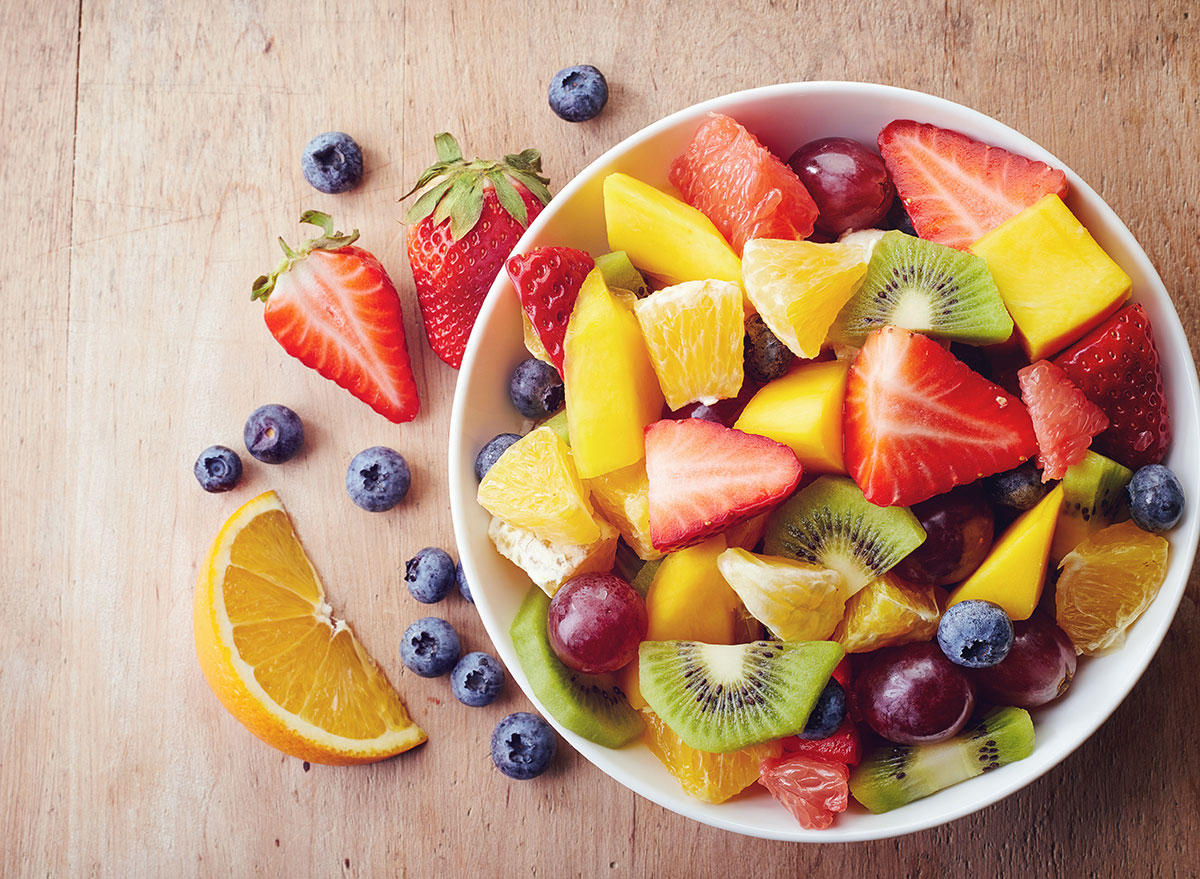
The pervasiveness of added sugar in our diets is linked to an increased risk of obesity, diabetes, heart disease, and stroke. But in the epic rush to avoid sugar, many health-conscious consumers and low-carb dieters are starting to avoid eating fruits because it contains natural sugar. Despite containing sugar, fruits are a part of a healthy diet when eaten in the right portions.
Is the sugar in fruit the same as added sugar?
Superficially, it could make sense; if you were to look at certain fruits’ nutrition labels, they may boast over 20 grams of sugar.
But this sugar isn’t the same as the kind that’s used in candy bars and ice cream. Isabel Smith, MS, RD, CDN, founder of Isabel Smith Nutrition, and New York City-based celebrity dietitian and fitness expert, weighs in: “It’s key to look at added sugars differently than sugar in fruit.”
“In fruit, we’re getting so much more nutrition [compared to refined sugar],” she adds. Fruit also comes with free-radical-fighting antioxidants, vitamins, minerals, phytochemicals, water, and fiber. This total package is what makes eating fruit so good for you.
Is fruit sugar good for you?
Countless studies have found that increased fruit consumption, regardless of the fruit’s sugar content, is tied to lower body weight and a lower risk of obesity-associated diseases.
Experts believe it’s because when you eat whole fruits, you’re also getting plenty of fiber. And this fiber helps you feel full while slowing the digestion of the fruit’s sugar (which keeps your blood sugar from spiking).
On the other hand, refined sugars are just empty carbs that lack these healthy nutrients, which is the reason why they’re metabolized quickly, lack the ability to make you feel full, and contribute to weight gain.
Is too much fruit sugar bad for you?
The old adage is still true: too much of anything isn’t a good thing.
While there are many benefits of eating fruit, “we still want to be mindful of how much fruit we’re eating because it does contain sugar,” explains Smith.
It’s not “added sugar,” but the sugar in fruit can still have the same blood-sugar-spiking effect if eaten in excess.
How many servings of fruit should you eat per day?
Smith usually recommends getting in 2-3 servings of fruit per day, and keeping it to a serving at a time.
And yes, that goes for smoothies as well. “Smoothies can be large whacks of carbs and sugar, especially if there’s no protein or healthy fat that acts similarly to fiber to slow digestion and prevent blood sugar from spiking,” she says.
As far as sugary fruits go? You can still eat the exceptionally sweet ones, but Smith recommends you eat these in smaller portions and pair them with extra fiber, a healthy fat like peanut butter, or protein such as a scoop of plant-based protein powder or Greek yogurt to slow digestion and blunt the sugar spike.
Figs
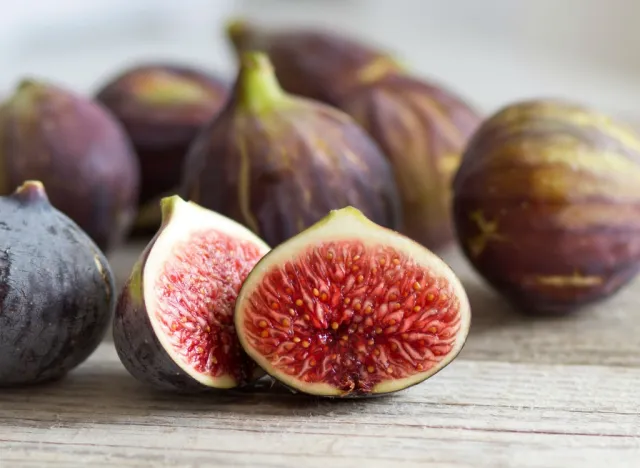
Total Sugar: 1 cup, chopped, 29.3 g
Fiber: 5.2 g
While you may only know this sweet fruit from its inclusion in the famous Fig Newton cookies, you’ll have to eat the fruit raw—and without the coating of sugar and flour—to best reap the health-protective benefits such as its high fiber, potassium, calcium, magnesium, and vitamins A, E, and K contents. Figs also contain prebiotics, which help support the pre-existing good bacteria in the gut, improving digestive wellness. But because of their high sugar content, be sure to enjoy by eating only one or two whole ones at a time. Try wrapping figs in prosciutto and adding a dollop of goat cheese. Both the meat and the cheese have extra protein to help fill you up so you don’t feel the need to keep munching.
Pomegranate Seeds
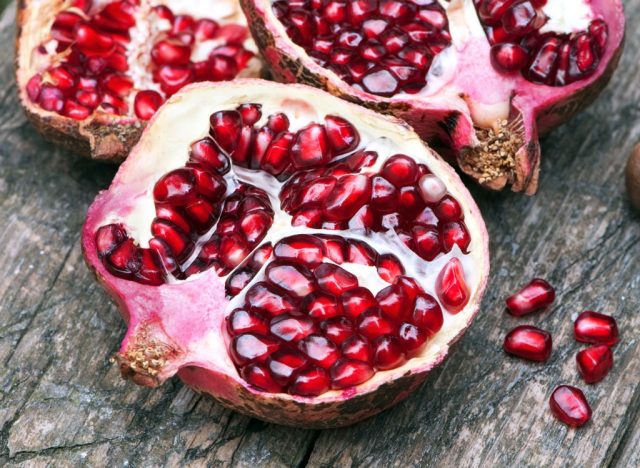
Total Sugar: 1 cup, arils/seeds, 23.8 g
Fiber: 7.0 g
No wonder pomegranate juice doesn’t need any added sweeteners. It’s sweet enough on its own! But it’s not just sugar pomegranates are high in; their arils (the seeds) are also pretty mighty when it comes to their nutrient content. Pomegranates contain three types of antioxidant polyphenols—including tannins, anthocyanins, and ellagic acid—which all help fight and prevent damage to your body caused by free radicals. One pomegranate also provides about 30 mg of vitamin C, which is important for skin and immune health. They have a fairly high fiber content, so as long as you stick to the serving size, don’t be afraid to pop the arils as a snack, sprinkle them onto salads, yogurt, or even on top of chicken dishes.
Grapes
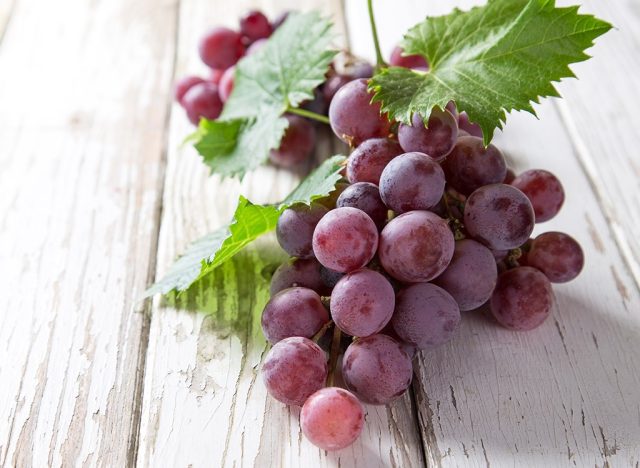
Total Sugar: 1 cup, 23.4 g
Fiber: 1.4 g
You can thank grapes’ sugar content for that pounding headache you get after downing a couple glasses of wine. And while both red and green grapes are high in sugar, they’re also rich in antioxidants. You may have heard that red wine is touted as a “healthy” alcoholic drink because of its resveratrol content—a plant compound that has been linked to improving heart health, burning fat, and boosting weight loss. But wine contains only a fraction of the resveratrol and other protective phenolic compounds found in grapes, so experts recommend the best way to boost your consumption of polyphenol compounds is by directly increasing fruit consumption. Here are some more secret effects of eating grapes.
Mango
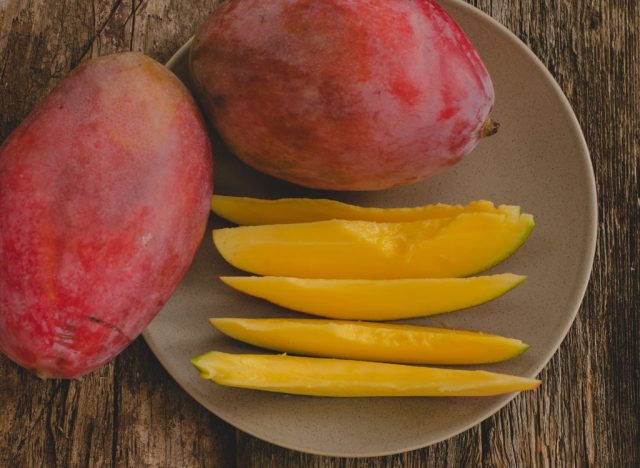
Total Sugar: 1 cup, pieces, 22.5 g
Fiber: 2.6 g
These glowing fruits are packed with eye-protecting vitamin A, heart-strengthening B6, and immunity-boosting C. Not to mention, their variety of antioxidants—quercetin, isoquercitrin, astragalin, fisetin, gallic acid, and methyl gallate—protect the body against colon, breast, leukemia and prostate cancers. When you’re adding it to your smoothie, make sure you add a healthy scoop of protein powder and a handful of raw oats to add to your protein and fiber content and slow down the digestion of its sugars.
Tangerines
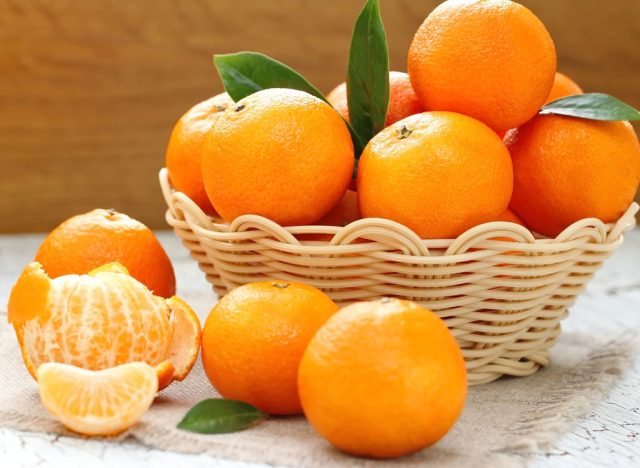
Total Sugar: 1 cup, sections, 20.6 g
Fiber: 3.5 g
You might also know these mini oranges as those little sections that grace your Chinese salads—mandarin oranges. These rank high for their sugar content, but you should know that a single tangerine, even the largest tangerine, has only 12.7 grams of sugar in it. So a cup is about 2 medium-sized tangerines total. Did you know tangerines give you better hair? The B12 in tangerines promotes hair growth, reduces hair loss, and slows down the graying process. Here’s the real difference between clementines and tangerines.
Bananas
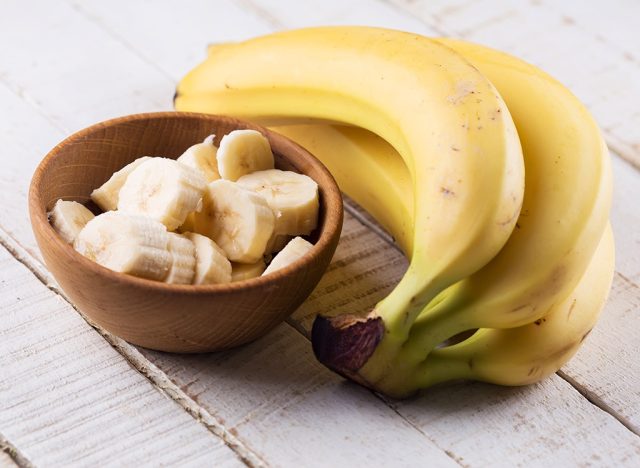
Total Sugar: 1 cup, sliced, 18.3 g
Fiber: 3.9 g
Bananas can help you sleep, build lean muscle, and burn fat, but compared to other fruits they’re pretty high in sugar and carbs, so no monkey business: stick to one five-inch portion a day. This ensures you’ll reap all the fruit’s benefits—without expanding your waistline.
Cassie Bjork, RD, LD, says, “I encourage consuming protein and healthy fat with the banana to slow down the absorption of the sugar from the banana into your bloodstream. This is the most effective strategy for keeping blood sugar levels stable, which means consistent energy levels and weight loss (since stable blood sugar levels allow the pancreas to secrete glucagon, the fat-burning hormone!)”
Sweet Cherries
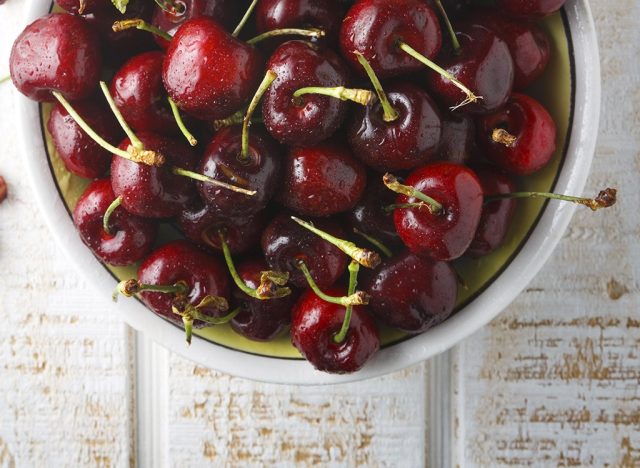
Total Sugar: 1 cup, with pits, 17.7 g
Fiber: 2.9 g
Besides sweet corn, nothing quite represents summer’s harvest like sweet cherries. One cup of the little red guys has about 306 milligrams of potassium (nearly that of a small banana), which helps keep blood pressure in check. Cherries also contain good amounts the antioxidants of quercetin and anthocyanin, which help protect against cancer and cardiovascular disease. Their solid hit of fiber helps to slow down the digestion of their high sugar content, but to be on the safe side, we’d suggest eating them in blogger Gimme Some Oven’s Cherry Pie Smoothie. The recipe combines fresh frozen cherries, nonfat Greek yogurt, old-fashioned oats, vanilla extract, and almond extract to create a delicious drinkable dessert. Here are some more surprising side effects of eating cherries.
Orange
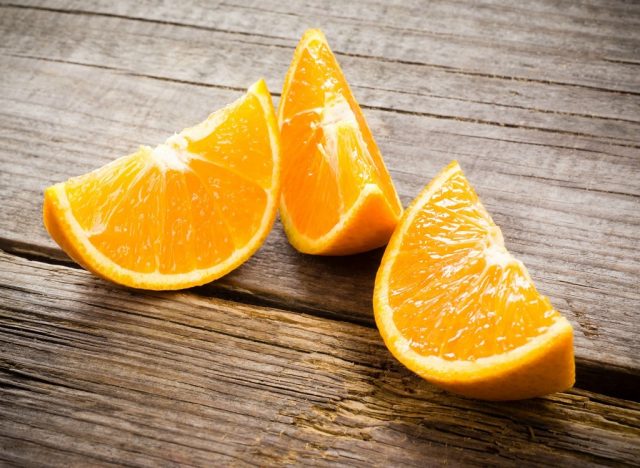
Total Sugar: 1 cup, sections, 16.8 g
Fiber: 4.3 g
If you’re a runner try switching your apple-a-day to an orange-a-day to help lessen muscle soreness after your run! Why? According to a study in the International Journal of Sport Nutrition and Exercise Metabolism, consuming vitamin C before a workout can reduce muscle soreness and prevent the formation of free radicals. A single orange supplies 116 percent of your DV for vitamin C. A bonus: Oranges are a great source of selenium, a trace element whose antioxidant power maintains thyroid function, fights fatigue, and boosts metabolism.
Plum
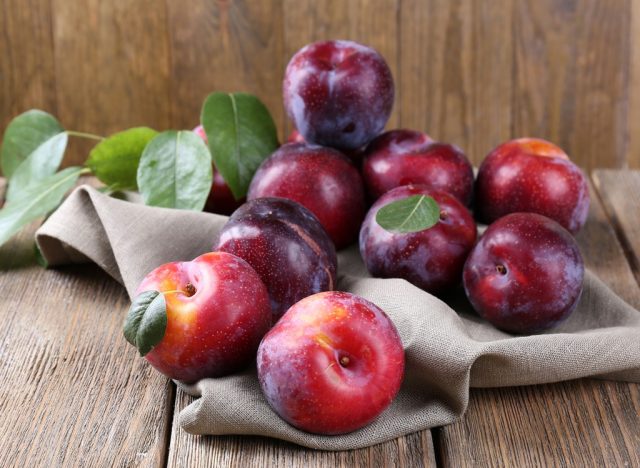
Total Sugar: 1 cup, slices, 16.4 g
Fiber: 2.3 g
Low in calories, this stone fruit is a sweet way to satisfy your hunger. Not only that, but studies by Texas AgriLife Research suggest plums may help ward off metabolic syndrome—a name for a group of risk factors, of which belly fat is a predominant determinant, that increase the risk for obesity-related diseases including diabetes. The belly-good properties of stone fruits come from powerful phenolic compounds that can modulate fat-gene expression.
Pineapple
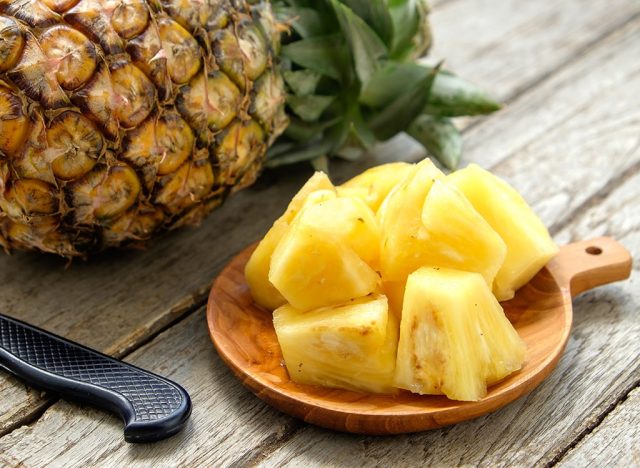
Total Sugar: 1 cup, chunks, 16.3 g
Fiber: 2.3 g
Feeling low on energy? A cup of pineapple might just be the antidote. That’s because pineapple is one of nature’s best sources of manganese, a trace mineral that is essential for energy production. A cup provides 76 percent of your daily recommended intake, making pineapple nature’s Red Bull.
Kiwi
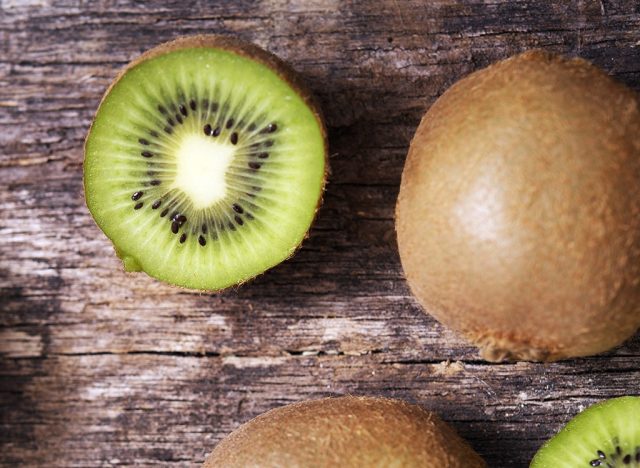
Total Sugar: 1 cup, sliced, 16.2 g
Fiber: 5.4 g
Did you know you’ve been eating kiwis wrong this whole time? It may be brown and fuzzy, but don’t let that turn you off. “The skin of kiwi fruits contains cholesterol-lowering fiber, antioxidants, and immune-boosting vitamin C,” says Lisa Moskovitz, RD, founder of The NY Nutrition Group. Just as you would rinse a peach or a pear to lower your exposure to pesticides and chemicals, washing kiwis is essential if you plan to bite right in.
Grapefruit
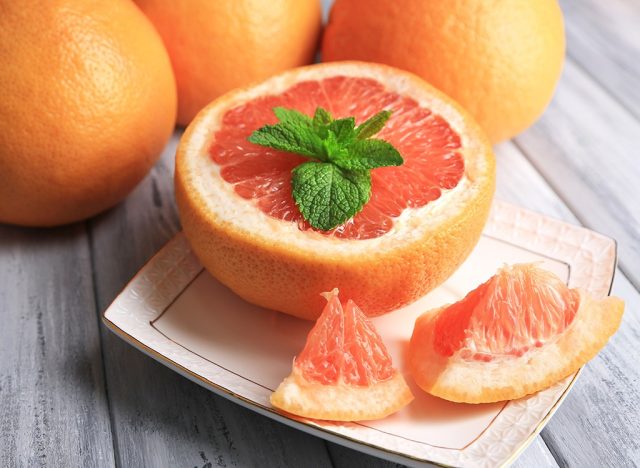
Total Sugar: 1 cup, sections, 15.9 g
Fiber: 3.7 g
Despite a higher sugar content, grapefruit is brimming with good-for-you vitamins and antioxidants. So just keep your serving to half a fruit. According to a study in the journal Nutrition & Metabolism, supplementing with grapefruit helped participants shrink their waists shrink by 1.7 inches and lose about seven percent of body fat! Researchers attribute the effects to a combination of phytochemicals and vitamin C in the grapefruit. Consider having half of a grapefruit before your morning oatmeal, and slicing a few segments to a starter salad, or try one of these delicious recipes that feature grapefruit.
Apricot
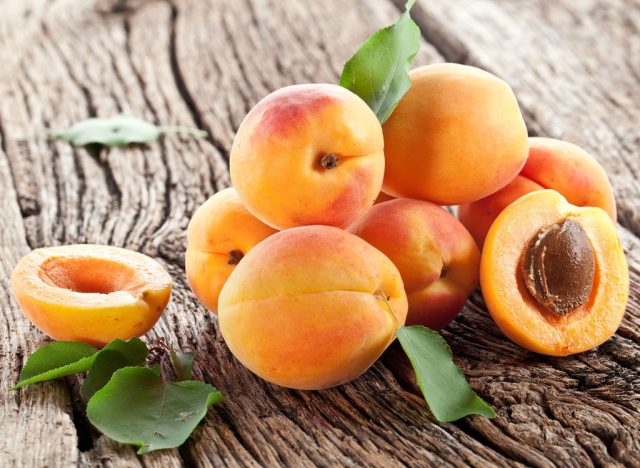
Total Sugar: 1 cup, sliced, 15.3 g
Fiber: 3.3 g
These sun-like fruits are sure to brighten your day and help you shed your winter weight. You might already know to eat dried apricots in moderation because of their high sugar content, but their fresh version isn’t as bad. Pick up fresh apricots during their short season in late spring to load up on vitamin A, a vitamin that helps your skin glow, and potassium. Besides flushing out extra water weight, potassium also keeps your metabolism running high, and is crucial for the digestion of nutrients such as carbohydrates and fat, as well as the absorption of energy from these nutrients.
Blueberries
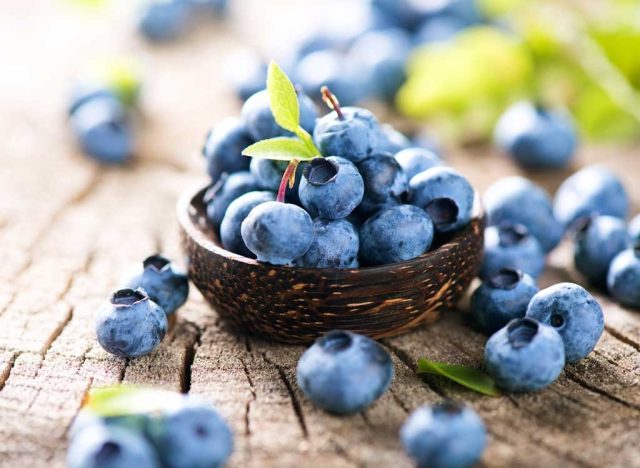
Total Sugar: 1 cup, 14.7 g
Fiber: 3.6 g
Touted for their high antioxidant content, blueberries are best known in health circles for anthocyanins, the phytonutrients that give them their blue-red tint and their dense antioxidant punch. That punch translates into serious brain food, as blueberries have been found in studies to protect our noggins against both oxidative stress and the effects of age-related mental decay manifested in Alzheimer’s and dementia. High in fiber, these berries are good to just pop in your mouth! Not only will you fight aging, but blueberries may also help perk things up in the bedroom.
Honeydew Melon
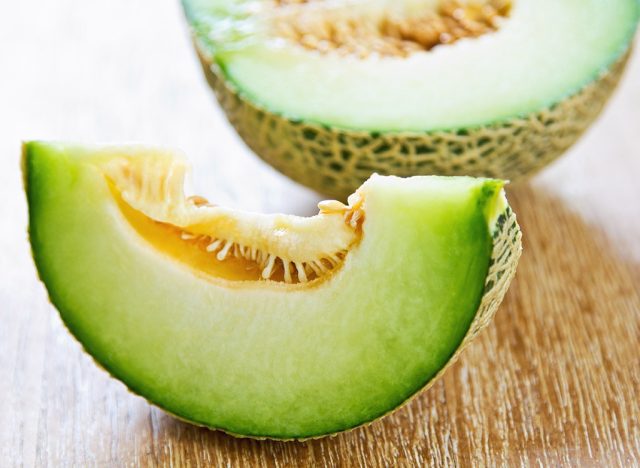
Total Sugar: 1 cup, diced, 13.8 g
Fiber: 1.4 g
A cup of honeydew carries is low in calories and is primarily made up of H20, making it a great food to keep in your flat belly arsenal year-round. Rather than fiber, the high water content is the thing that keeps you full, which can help you lose weight over time, but it also brings more immediate slimming results to the table thanks to its natural bloat-busting, diuretic effect. But without fiber, you’ll likely experience a spike in blood sugar, so be sure to pair honeydew with veggies like fennel and olives in a salad to add some fiber.
Pear
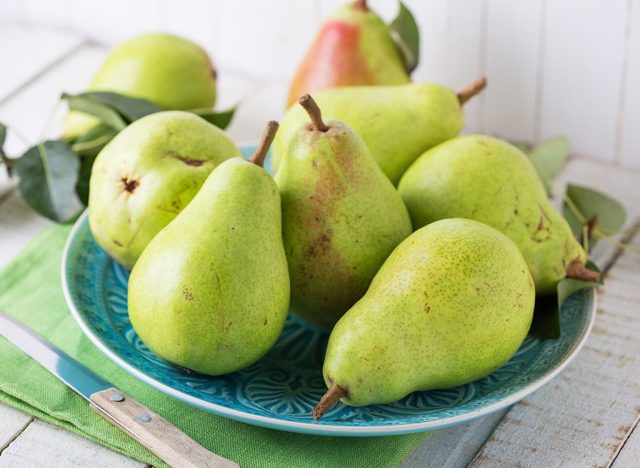
Total Sugar: 1 cup, slices, 13.7
Fiber: 4.3
Pears are so sweet that it seems impossible they only contain about 100 calories each, but it’s true. This fall fruit is a good source of vitamin C and contains 6 grams of fiber per medium fruit (24% of your daily value). Pears help keep hunger at bay thanks to pectin, “a soluble fiber that attracts water and turns to gel, slowing down digestion,” says Jennifer Glockner, RDN, “which may help to reduce blood cholesterol and reduce the risk of heart disease and colon cancer.”
Apple
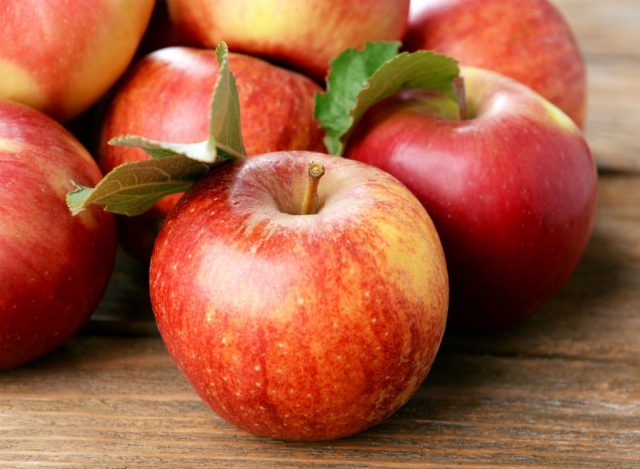
Total Sugar: 1 cup, chopped (with skin), 13 g
Fiber: 3 g
This humble fruit is so much more than just a seasonal filler for pie—although we’ve got to admit, that’s a pretty great way to use them, too. Apples are not only a portable, no-mess snack but also powerful fat fighters. Isabel Smith, MS, RD, CDN says they’re a great snack for people with diabetes and insulin resistance because they’re high in fiber to slow sugar spiking.
Peach
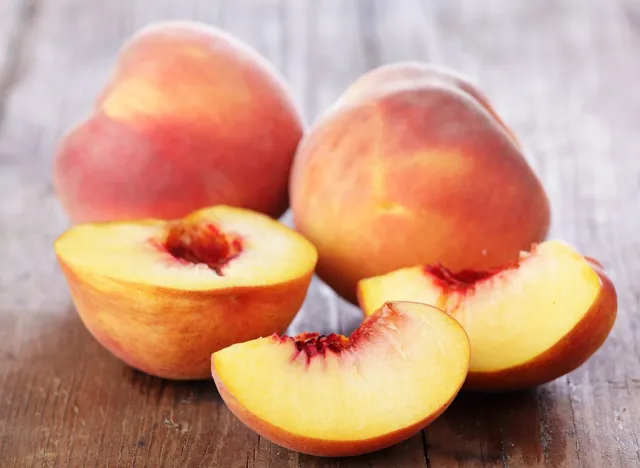
Total Sugar: 1 cup, slices 12.9 g
Fiber: 2.3 g
If you want to lose weight, just pick up a peach! According to Texas A&M University researchers, the stone fruit contains phenolic compounds that modulate different expressions of genes to ward off obesity, high cholesterol, inflammation, and diabetes—now that’s something to feel peachy about!
Cantaloupe
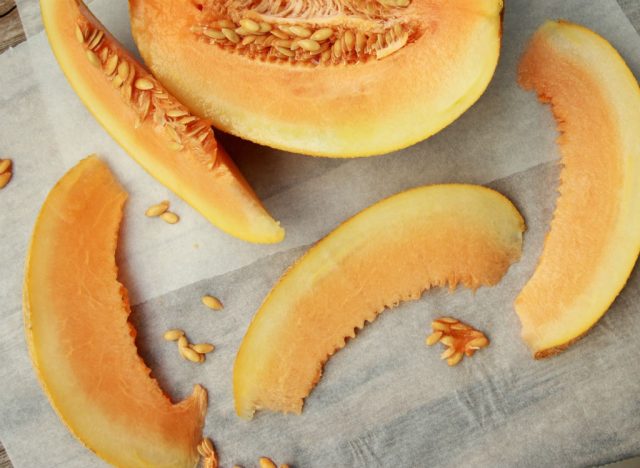
Total Sugar: 1 cup, cubes, 12.6 g
Fiber: 1.4 g
Cantaloupe is juicy, light, and extremely high in water content. But that’s not the only reason it’s hydrating. The melon is also high in potassium, with 1 cup providing 14 percent of your DV. Not to mention that same cup provides over 100 percent of your DV of vitamin A, the fat-soluble vitamin that helps maintain eye and skin health in addition to boosting immune function. This healthy treat is also one of the low-carb fruits to help you lose weight fast.
Nectarines
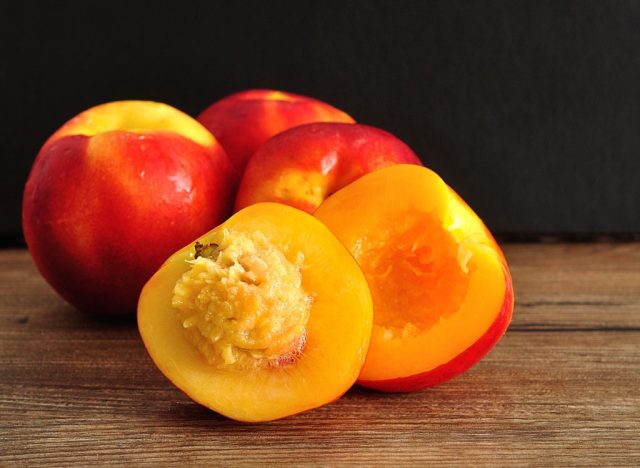
Total Sugar: 1 cup, slices, 11.3 g
Fiber: 2.4 g
The smoother cousin of the peach, nectarines just barely edged out its look-a-like for lower sugar content and higher fiber. Like peaches, nectarines are also high in beta-carotene and vitamins A and C. They’re also full of potassium, an important mineral for proper cellular functions in the body, including regulating metabolism, maintaining pH balance, assisting with protein synthesis, and helping with the digestion of carbohydrates.
Watermelon
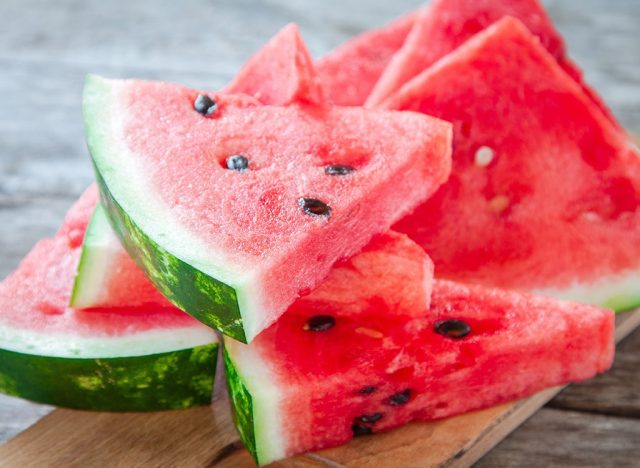
Total Sugar: 1 cup, diced, 9.4 g
Fiber: 0.6 g
For being so high on our list, you’re probably wondering why watermelon gets a bad rap for being high in sugar. It could partly be because it tastes so sweet, and it’s low in slow-digesting fiber, causing it to rank high on the glycemic index; however, in reality, it has a very small impact on your blood sugar levels because it’s low in total carbs. Good news, because watermelon has some impressive health benefits: Research published in the Journal of Nutritional Biochemistry showed that eating watermelon may improve lipid profiles and lower fat accumulation. We’re looking forward to those summer watermelon-eating contests!
Blackberries
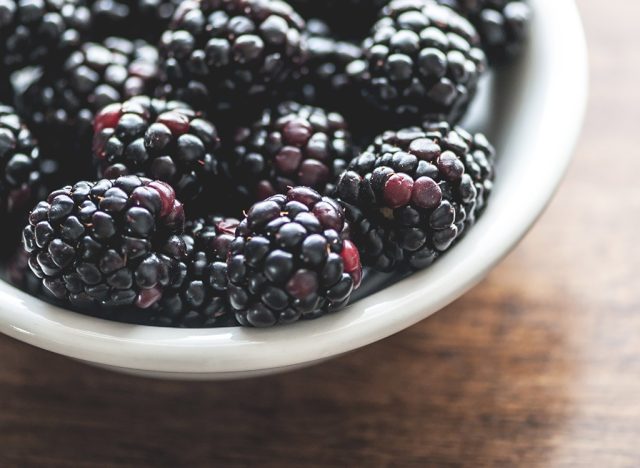
Total Sugar: 1 cup, 7 g
Fiber: 7.6 g
All berries are an incredibly rich source of antioxidants, but blackberries are particularly potent in this regard. And with more grams of fiber, than there are grams of sugar, you can snack on them knowing they’ll be furthering your weight loss goals. The dark color of this particular berry tips you off to their high antioxidant content. These lush-looking berries help protect against heart disease and fight against age-related cognitive decline.
Strawberries
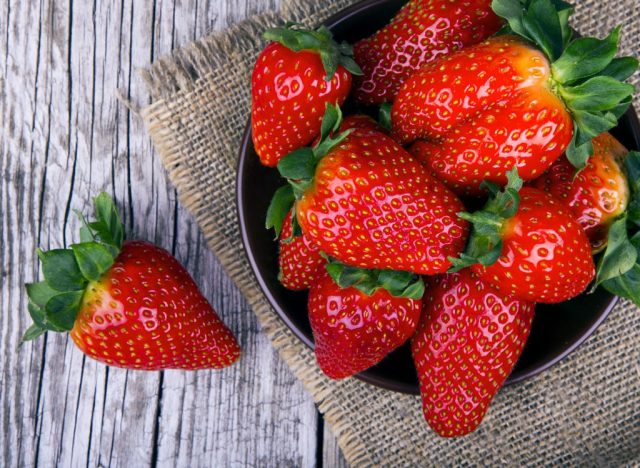
Total Sugar: 1 cup, halves, 7.4 g
Fiber: 3.0 g
Strawberries are basically nature’s candy. Pop a cup of these into your mouth to increase your vitamin C intake and, in turn, help boost your immune system and reduce stress. When it comes to how to prepare them, be sure you’re eating them whole—slicing up strawberries exposes them to light and oxygen, which can break down their precious vitamin C!
Raspberries
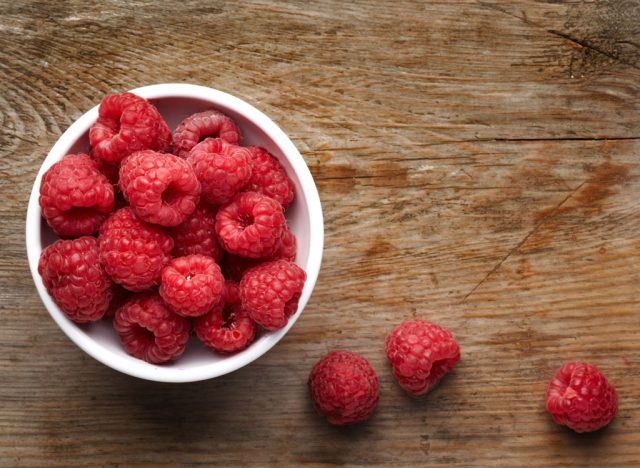
Total Sugar: 1 cup, 5.4 g
Fiber: 8.0 g
Raspberries may be small, but they’re mighty—think of them as nature’s magical weight loss pill. Packing the highest fiber count of all these other fruits, raspberries boost feelings of satiety without doing any damage to your waistline. Eat them solo or throw them in Greek yogurt for a quick snack.
Cranberries
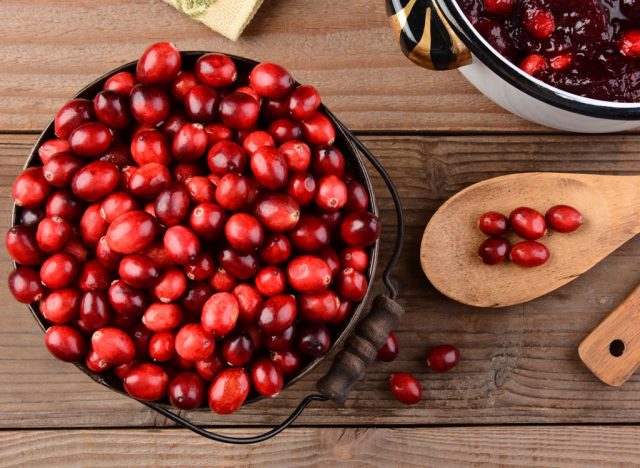
Total Sugar: 1 cup, whole, 4.3 g
Fiber: 3.6 g
Cranberries are so low in sugar that when the FDA proposed requiring food labels to list added sugar as a separate category from sugar, Ocean Spray (the cranberry juice company) wrote a letter requesting exemption because, “cranberries … are naturally low in sugar, giving them a distinctly tart, astringent, and even unpalatable taste.” (And yes, that is a direct quote from their official letter to the FDA.) Yep. Ocean Spray basically said that cranberries need sugar to taste good. But they don’t! Eat them without the sugar in an antioxidant-packed oatmeal bowl. Create a one-cup serving of mixed fruits—cranberries, apples, and blueberries. Combine with walnuts and add to a bowl of oatmeal. In an American Chemical Society analysis of the cancer-fighting phenol antioxidant content of 20 fruits, cranberries were found to have the highest amount.
Read more:
40+ Best & Worst Fish to Eat—Ranked by Nutritional Benefits!